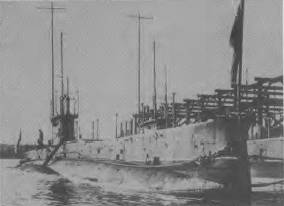- Author
- Smith, Peter
- Subjects
- Ship design and development
- Tags
-
- RAN Ships
- HMAS Oxley I, HMAS Otway I, HMAS Orion, HMAS K9, HMAS Collins, HMAS Watson (base), HMAS Penguin (Shore Base - Balmoral), HMAS Penguin I, HMAS Oxley II, HMAS Stirling (Shore establishment), HMAS Ovens, HMAS Otama, HMAS Onslow, HMAS AE1, HMAS AE2
- Publication
- June 1993 edition of the Naval Historical Review (all rights reserved)

On February 28, 1914, Australia’s first submarines were commissioned at Portsmouth, England. They were AE1 and AE2, boats which for very different reasons would become an important part of Australia’s history.
AE1 and AE2 (the A standing for Australia, the E for the Class) left Portsmouth in early March 1914 and arrived in Sydney on 24th May, a scant three months before the outbreak of World War I. There was little time to repair the minor problems which had become evident on the voyage to Sydney before both submarines were called upon to enter ‘the war to end all wars’.
AE1 – An Unsolved Mystery
They were assigned to operations in the waters off New Britain, but it was a mere one month after they had deployed that AE1 disappeared without trace. The loss of AE1 and her crew is still one of Australia’s maritime mysteries. She left Blanche Bay in the early hours of 14th September for a routine patrol in company with HMAS PARRAMATTA. She was seen around 3.30 that afternoon presumably on her way back into harbour, but she never arrived. Despite a concentrated search, no sign was ever found of the submarine – no wreckage, no oil slick, nothing to give a hint of what may have happened to the submarine that had become Australia’s first loss of the war.
AE2 – Part of the Gallipoli Story
When we think of Gallipoli, images of soldiers in their trenches or the mass landings at Anzac Cove come to mind. We are unlikely to think of AE2, but it’s this Australian submarine which penetrated the Dardanelles in the hours before those famous beach landings, that also deserves a place in the Gallipoli story.
After AE1’s loss off New Guinea, AE2 was offered to the Admiralty and she subsequently joined the British naval squadron in the Mediterranean. AE2’s mission was to penetrate the Dardanelles and harass enemy shipping in the Sea of Mamara. This was no easy assignment, two previous attempts had failed, but AE2 slipped into the straits in the early hours of 25th April, 1915. In the days following her successful penetration of the Dardanelles, AE2 repeatedly surfaced to observe the enemy, only to be forced to dive to avoid being fired on. Finally, on April 30, her wartime service ended when she was attacked by a Turkish torpedo-boat. The Captain ordered all hands on deck and flooded the submarine. The crew spent the rest of the war in a prisoner of war camp; one officer and three sailors died there.
AE2 was the first RAN vessel to be lost by enemy action and, together with AE1, formed the basis for Australia’s submarine history.
The “J” Class – An `Admirable’ Gift
With the hostilities of World War 1 over, the Admiralty found itself with too many ships for a peace-time Navy. The British presented, as a gift, a squadron of three minesweepers, five destroyers, a flotilla leader and six “J” class submarines to the Australian Government.
At that time the “J”s were the fastest submarines in the world. They were built in 1916 to counter the threat of what British Intelligence believed were German submarines capable of reaching surface speeds of up to 22 knots. The “J”s were a hotch-potch of submarine design. The conning tower was taken from the E class, with its proven sturdy construction. The Vickers diesel engines were also from the E class but extended from 8 to 12 cylinders for greater speed, and the low pressure blower and air systems were from the Nautilus class. The design was completed in just eight weeks, the plans were handed to the dockyard in January 1915 and the first of seven submarines was commissioned in June the following year.
In April 1919, the six surviving submarines (J6, whilst in service with the RN, was accidentally sunk by friendly fire in 1918) accompanied by the Submarine Depot Ship HMAS PLATYPUS, left Portsmouth for Australia. They arrived in Sydney in July, all in need of refit. Because of this, they saw little sea time before the decision was made in 1922 to pay the flotilla off. The Navy budget, which had been slashed by 25 percent, couldn’t sustain the submarines and they had an inglorious end, stripped of fittings and equipment and sunk, some as breakwaters. J7 managed to hang on longer than the others. She remained at Flinders Naval Depot, at one stage acting as an auxiliary power plant, until 1930 when she too was sunk as a breakwater in Port Phillip Bay.
For the second time in its brief history, the submarine arm of the Royal Australian Navy had ceased to exist.




